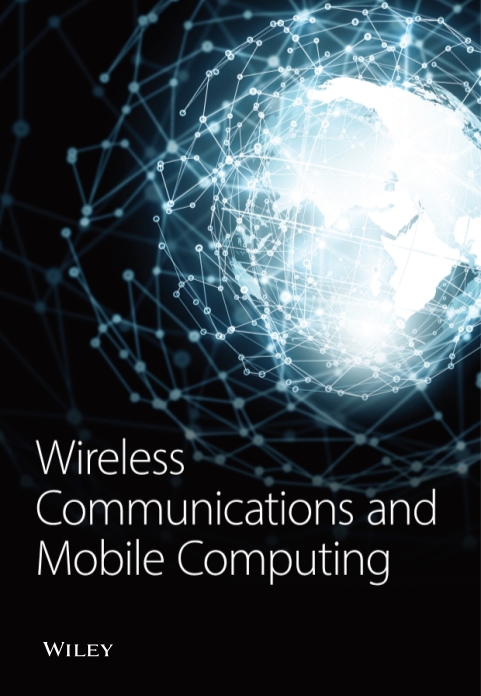[Retracted] Multifunctional Robot Grasping System Based on Deep Learning and Image Processing
Abstract
This paper firstly introduces the general architecture of the multifunctional harvesting robot grasping system; then, deep learning is used to investigate the object target recognition, and a set of target detection algorithm based on convolutional neural network is implemented; then, image processing technology is used to realize the function of target object localization, which can guide the multifunctional harvesting robot to complete the picking of the target multifunctional. The experimental results show that the multifunctional harvesting robot has a small calculation error of multifunctional coordinates and has a strong multifunctional recognition and positioning capability.
1. Introduction
With the development of automation technology, robotics has grown by leaps and bounds, and a variety of intelligent robots are used in industrial, medical, educational, and agricultural applications. Robot grasping is an important function of robots in industrial scenarios, which is traditionally implemented based on manual teaching methods and 2D or 3D model matching to obtain grasping postures [1]. The former does not address the need to capture any object in any pose; the latter requires a large number of templates for different objects to be created in advance, and more than one template may be needed for the same object, making it laborious to build a template search library [2]. In order to solve this problem, the common method is to build grasping classifiers through machine learning algorithms for grasping pose planning, but these grasping classifiers often require human feature design, which is empirical and heuristic, and different features need to be designed for different grasping conditions, making human feature design difficult, inefficient, and impractical [3].
In recent years, with the increase in GPU computing power and the rapid development of deep learning technology, deep neural networks driven by big data can learn the deep features corresponding to things or behaviours, especially for feature learning and expression of two-dimensional data, such as in image classification, object detection, semantic segmentation, and behavioural recognition research fields; the effect achieved by convolutional neural networks has far surpassed the traditional detection algorithms and even surpass human recognition in some areas [4]. The introduction of deep learning algorithms in robot grasping research, where convolutional neural networks are used to extract feature information of grasping poses in a hierarchical manner, can solve important challenges that previously required human-designed grasping features [5].
Furthermore, the use of convolutional neural networks allows for autonomous and efficient learning of feature representations of grasping poses from a large training dataset compared to inefficient human-designed features, resulting in improved performance of grasping pose detection algorithms [6].
In summary, the application of deep learning techniques to robot grasping pose detection algorithms not only eliminates the tedious work of building templates and human-designed features but also allows for efficient grasping planning of target objects, which is of great value for research. In this study, we investigate how to identify and locate objects in a scene and design a well-structured convolutional neural network as a feature extractor for grasping poses.
2. Related Work
2.1. Object Detection
Current deep learning-based object detection methods can be categorised into two types depending on the implementation, Two-Stage object detection algorithms and One-Stage object detection algorithms. The R-CNN algorithm proposed by [7] outperforms the OverFeat end-to-end processing method proposed by [8] and improves the performance by about 50% compared to the traditional object detection algorithm. The YOLO algorithm proposed in [9] follows the regression-based One-Stage approach of the OverFeat algorithm to achieve true end-to-end object detection, and its improved version, YOLOv2 [10], can achieve a detection speed of 155 fps, but the YOLO-like algorithm also has shortcomings, as it is not rational for detecting small objects and objects with overlapping parts, and the algorithm’s generalization capability and localization frame accuracy are insufficient. In [11], an SSD detection algorithm is proposed, which predicts object regions on the feature maps output by different convolutional layers, outputs discrete default box coordinates of multiple scales and proportions, and uses small convolutional kernels to predict the coordinate compensation values and category confidence of the candidate boxes.
2.2. Current Status of Robot Gripping Research
The application of machine vision technology to achieve robot grasping is to determine the relationship between the camera coordinate system and the robot base coordinate system, use the technology related to vision algorithms to detect the 3D poses of the target object, and implement the grasping action according to the detection results. In [12], a matching method is proposed for estimating the target pose, where a library of templates of the target object is created, its SIFT feature points and corresponding descriptors are detected, and the single-response matrix between the template and the target is derived by a matching algorithm. Reference [13] also used SIFT features to build a sparse 3D model as a template based on the feature point pairs and used a matching algorithm to identify the predicted target’s pose information. Reference [14] proposed an object recognition and pose detection algorithm with real-time feedback for object colour and shape characteristics; however, the algorithm is not stable due to the effect of illumination and background. Reference [15] used a sliding window approach to generate multiple candidate grasping poses and then used a neural network to discriminate the optimal grasping pose, which is a less efficient method to obtain the optimal solution by traversing the search. In [16], a random sampling method was attempted to reduce the time-consuming candidate frame generation, but the final result was not significant. In [17], a cascaded convolutional neural network was proposed, with the first half applying an R-FCN network to locate the target capture position and coarse capture angle classification prediction for RGB images and the second half refining the capture angle prediction by Angle-Net. A large amount of training data is obviously required to make the network model eventually achieve better results, as proposed in [18], to transform the positional detection problem into an angle classification problem by using the rotation angle as the label; however, labelling such a high-quality grasping angle dataset requires a lot of labour and resources. To simplify the annotation of the grasp angles, [19] proposed a grasp detection network GDN with both the image and the grasp angle as input and the output as the rating of that grasp angle, selecting the highest rating from 18 candidate grasp angles (divided into 18 such as 180°) as the detection result. This approach obviously simplifies the dataset production process at the expense of computational efficiency.
In order to improve the efficiency of dataset production, [20] proposed to conduct simulated grasping experiments in a simulation environment to collect the dataset, and their proposed Dex-Net2.0 system can achieve fast and accurate grasping of known objects through its own deep learning system for the 10,000 3D object models with different characteristics in the virtual object model library graph.
In an end-to-end implementation, [18] uses a neural network to generate the centroid of the grasp and the coordinates of the mechanical claw fingers directly from a local view of the target object. Reference [19], on the other hand, proposed a deep reinforcement learning algorithm for autonomous grasping based on deep Q-functions, whose experiments showed that the reinforcement learning algorithm could imitate complex movements and even plan the robot to achieve door opening.
3. Overall Design of the Multifunctional Harvesting Robot Gripping System
The studied multifunctional harvesting robot grasping system consists of an industrial camera, an image processing module, a multifunctional robot carrier, and a data processing unit (PC). The industrial camera is mounted on the robot arm of the multifunctional robot and is responsible for collecting information about the surrounding environment of the orchard and the multifunctional targets; the image processing module is responsible for processing the image information collected by the industrial camera; for example, the fruit robot is responsible for movement and grasping of the multifunctional targets; the data processing unit is responsible for further analysis of the image information to achieve identification and positioning of the multifunctional targets. The workflow of the multifunctional harvesting robot is shown in Figure 1.
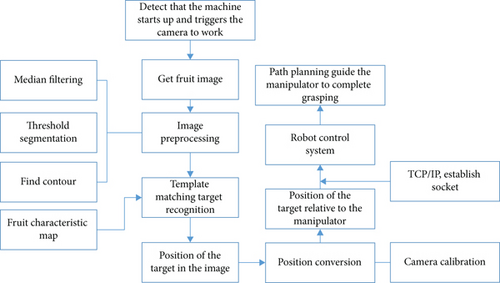
When working, the industrial camera is used to capture images of the orchard environment and the multifunctional target, which is simply processed and compressed by the image processing module of the multifunctional robot and sent to the PC in the background; the PC in the background uses image processing and deep learning algorithms to preprocess, threshold segmentation, feature extraction, and camera calibration of the images; then, the module matches and identifies the position and coordinates of the multifunctional to be picked. After obtaining the relative position of the target multifunction relative to the multifunction robot, the background PC communicates with the multifunction robot via TCP/IP protocol, sends the coordinate information of the position of the multifunction to be picked to the robot, and guides the multifunction robot to carry out the picking operation to achieve the picking of the target multifunction.
4. Target Identification
The PC quickly identifies the multifunction, locates it in three dimensions, and sends the coordinates and picking instructions to the multifunction robot, which then completes the picking operation.
The former uses RCNN, FCN, and other algorithms to detect targets in the image region, while the latter transforms the detection problem into a regression problem to be solved. The latter is faster in detection but has lower accuracy and is not suitable for multifunctional robots with high accuracy in target recognition. Therefore, RCNN is used as the target detection algorithm for multifunctional robots.
The RCNN regional target detection algorithm differs from other algorithms in that it uses a convolutional neural network to extract the target features.
- (1)
Create a convolutional neural network model for extracting image features
- (2)
Extract all the suspected regions in the image using a selective search method
- (3)
Train a SVM classifier to classify the extracted features
- (4)
Use regressor to correct the target regions to achieve target fruit recognition
Compared to traditional target feature extraction methods, the convolutional neural network structure used allows for the extraction and recognition of multilevel features; i.e., RCNN is able to ensure accurate recognition while avoiding complex manual feature extraction. The RCNN is also effective in detecting complex surroundings, as shown in Figure 2.
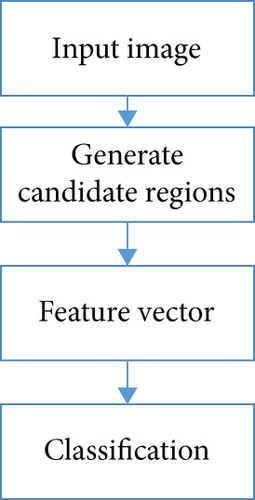
5. Target Localisation Based on Image Processing
After the backend PC identifies the multifunctional target, it also needs to obtain the location information of the target before the multifunctional robot can achieve the picking operation, which is very similar to the positioning method of the tennis picking robot. The image processing-based target positioning includes a backend PC and an industrial camera. The PC then uses the image processing algorithm to position the target multifunctionally based on the previous recognition results.
6. Experimental Results and Analysis
In order to verify that the multifunctional harvesting robot grasping system based on deep learning and image processing meets the design requirements, practical grasping experiments were carried out using the system. In the gripping experiments, the accuracy of the multifunctional robot gripping system was judged mainly by the coordinate error of the target multifunction. The coordinate data of the multifunctional robot grasping system is shown in Table 1.
| Fruit actual coordinates | Coordinate error | |||||
|---|---|---|---|---|---|---|
| x | y | z | Δx | Δy | Δz | |
| 1 | -0.593 | -0.27 | 0.855 | -0.2 | -0.3 | 0 |
| 2 | -12.357 | -21.252 | 16.738 | -0.1 | -0.5 | 0.2 |
| 3 | 8.58 | -5.264 | 8.625 | 0.3 | 0.2 | 0.1 |
| 4 | 15.714 | 8.521 | 0.859 | -0.4 | -0.1 | 0.2 |
| 5 | -6.431 | -1.371 | 23.083 | -0.2 | -0.5 | 0.1 |
Table 1 shows that the coordinate errors in all three axes are less than -0.5, and in the z-axis, the errors are within 0.2, indicating that the system has a strong multifunctional identification and positioning capability.
In order to further verify that the posture output of the proposed robot grasping posture detection system can achieve actual robotic two-finger grasping, an autonomous grasping experiment was set up to verify this. The human-computer interface is shown in Figure 3 and includes image display controls, function buttons, and parameter display controls. The Get_Image button controls the image acquisition and image preprocessing, while the Detect button implements the object detection function and displays the object detection result on the top right of the interface.
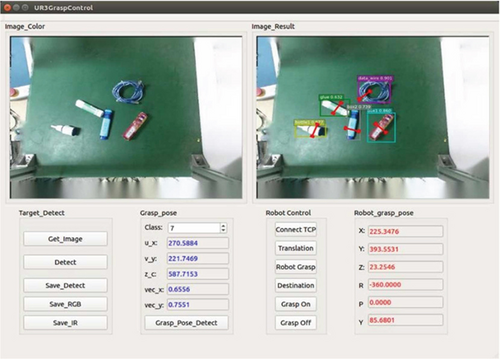
As shown in Figure 4, the target recognition effect can be achieved by adjusting the value of the Class control to display the grasping position parameters of the corresponding object; the Connect_TCP button enables communication between the computer and the robot console; the Translation button maps the grasping position to the robot grasping parameters and displays the parameter values; the Robot_Grasp button controls the movement of the robot to the corresponding position to grasp the object. The Robot_Grasp button controls the robot’s movement to the corresponding position for grasping objects; the Grasp on and Grasp off buttons control the opening and closing of the gripper, respectively; the Destination button controls the robot’s movement to the object placement point after the grasping action has been completed, and the robot grasps the object using this control software [21].
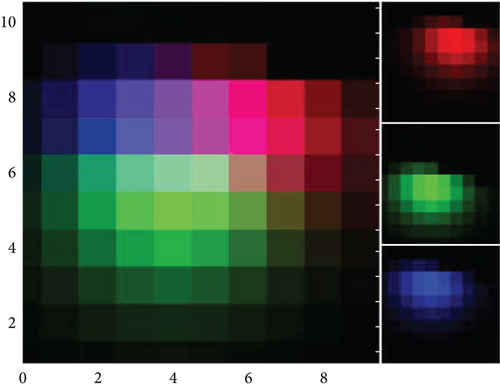
- (a)
The robot moves to a priming position with the air grasp in an open state
- (b)
The robot control receives the grasping position of the target object, drives the robot to move directly above the target, and then adjusts the end joint angle to the yaw angle of the corresponding grasping position
- (c)
The robot moves downwards until it reaches the gripping position
- (d)
The air grip closes and the gripping action is performed
- (e)
The robot grips the target object and lifts it upwards
- (f)
The robot transports the target object directly above the set placement point
- (g)
The robot moves downwards to the object placement point
- (h)
The air grip opens and releases the object, completing a single object gripping action
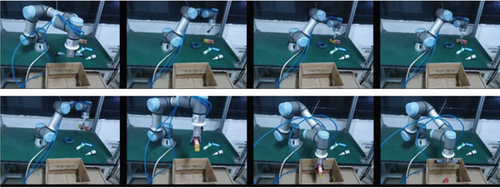
After a total of 100 actual gripping tests for each object tested, the overall gripping success rate was 84%. In the case of the metal bottle and the data cable, the results were not satisfactory, with a success rate of 60% for both items.
The main reason for the optimised target recognition as shown in Figure 6 is that the smooth metal bottle body affects the imaging effect of the depth map, which ultimately leads to a low success rate of effective grasping position detection, while in the data line grasping experiment, the main reason for the low grasping success rate is limited by the hardware configuration of the two-finger gripper; the two-finger gripper used in the experiment is a pneumatic hand claw, which cannot be fully closed, and after closing, there is still a 16 mm gap between the two fingers There was still a 16 mm gap between the two fingers, which did not allow for a secure grip on the small cross-sectional width of the cable, and the air grip failed to make a secure contact when closed. This is the main reason for the 7% difference between the overall gripping success rate and the effective gripping posture detection success rate, which could be improved by replacing the gripper with a better performing one.
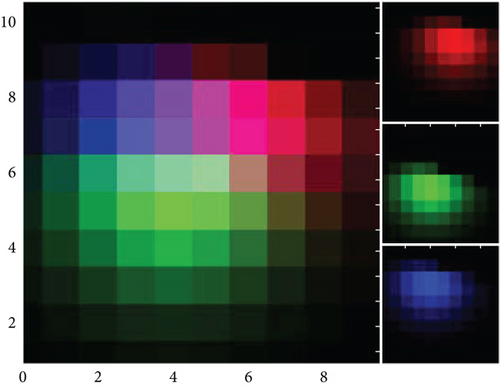
The autonomous robot grasping experiments in this section demonstrate that the proposed grasping pose detection system is effective in the robot grasping planning task by mapping the pose results to the robot base coordinates for the target object.
7. Conclusions
Using an industrial camera as the image acquisition sensor, the multifunctional robot transmits the image information collected by the industrial camera to the PC in the background in real time through the network, and the PC uses image processing and deep learning algorithms to recognize and analyze the image, send the coordinates of the multifunctional to be picked to the multifunctional robot, and guide it to carry out the picking operation, which realizes the robot’s grasping and positioning of the target multifunctional and is of great significance to improve the recognition accuracy of the multifunctional robot and realize the automation of multifunctional picking.
Conflicts of Interest
The authors declared that they have no conflicts of interest regarding this work.
Open Research
Data Availability
The datasets used in this paper are available from the corresponding author upon request.



